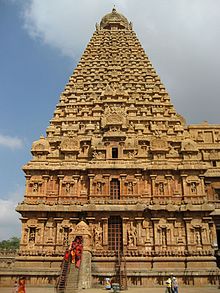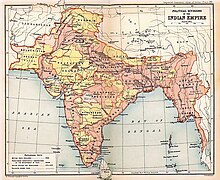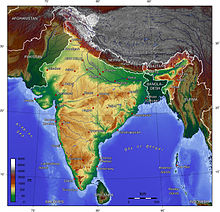Ancient India
The earliest anatomically modern human remains found in South Asia are from approximately 30,000 years ago.[19] Near contemporaneous Mesolithic rock art sites have been found in many parts of the Indian subcontinent, including at the Bhimbetka rock shelters in Madhya Pradesh.[20] Around 7000 BCE, the first known neolithic settlements appeared on the subcontinent in Mehrgarh and other sites in western Pakistan.[21] These gradually developed into the Indus Valley Civilisation,[22] the first urban culture in South Asia,[23] which flourished during 2500–1900 BCE in Pakistan and western India.[24] Centred around cities such as Mohenjo-daro, Harappa, Dholavira, and Kalibangan, and relying on varied forms of subsistence, the civilisation engaged robustly in crafts production and wide-ranging trade.[23]During the period 2000–500 BCE, many regions of the subcontinent evolved from copper age to iron age cultures.[25] The Vedas, the oldest scriptures of Hinduism,[26] were composed during this period, and historians have analyzed these to posit a Vedic culture in the Punjab region and the upper Ganges Plain.[25] Most historians also consider this period to have encompassed several waves of Indo-Aryan migration into the subcontinent from the northwest.[26] The caste system, creating a social hierarchy, appeared during this period.[27] In the Deccan, archaeological evidence from this period suggests the existence of a chiefdom stage of political organization.[25] In South India, the large number of megalithic monuments found from this period,[28] and nearby evidence of agriculture, irrigation tanks, and craft traditions suggest progression to sedentary life.[28]
By the fifth century BCE, the small chiefdoms of the Ganges Plain and the northwest regions had consolidated into 16 major oligarchies and monarchies called Mahajanapadas.[29] The emerging urbanization as well as the orthodoxies of the late Vedic age created the religious reform movements of Buddhism and Jainism.[30] Buddhism, based on the teachings of India's first historical figure, Gautam Buddha, attracted followers from all social classes;[31] Jainism came into prominence around the same time during the life of its exemplar, Mahavira.[32] In an age of increasing urban wealth, both religions held up renunciation as an ideal,[33] and both established long-lasting monasteries.[34] Politically, by the 3rd century BCE, the kingdom of Magadha had annexed or reduced other states to emerge as the Mauryan Empire.[34] The empire was once thought to have controlled most of the subcontinent excepting the far south, but its core regions are now thought to have been separated by large autonomous areas.[35] The Maurya kings are known as much for their empire building and determined management of public life as for Ashoka the Great's renunciation of militarism and his far flung advocacy of the Buddhist dhamma.[36]
The Sangam literature of the Tamil language reveals that during the period 200 BCE–200 CE, the southern peninsula was being ruled by the Cheras, the Cholas and the Pandyas, dynasties that traded extensively with the Roman Empire and with west and south-east Asia.[37] In north India during the same time, Hinduism asserted patriarchal control within the family.[38] By the fourth and fifth centuries CE, the Gupta Empire had created a complex administrative and taxation system in the greater Ganges Plain that became a model for later Indian kingdoms.[39] Under the Guptas, a renewed Hinduism based on devotion rather than the management of ritual began to assert itself[40] and was reflected in a flowering of sculpture and architecture, which found patrons among an urban elite.[41] Classical Sanskrit literature flowered as well, and Indian science, astronomy, medicine, and mathematics made significant advances,[41]
Medieval India
The Indian early medieval age (600 CE to 1200 CE) is defined by regional kingdoms and cultural diversity.[42] When Harsha of Kannauj, who ruled much of the Ganges plain from 606 to 647 CE, attempted to expand southwards, he was defeated by the Chalukya ruler of the Deccan.[43] When his successor attempted to expand eastwards, he was defeated by the Pala king of Bengal.[43] When the Chalukyas attempted to expand southwards, they were defeated by the Pallavas from farther south, who in turn were opposed by the Pandyas and the Cholas from still farther south.[43] No ruler of this period was able to create an empire and consistently control lands much beyond his core region.[42] During this time, pastoral peoples whose land had been cleared to make way for the growing agriculture economy were accommodated within caste society, as were new non-traditional ruling classes.[44] The caste system consequently began to show regional differences.[44]After the tenth century, Muslim Central Asian nomadic clans, using swift horse cavalry and raising vast armies united by ethnicity and religion, repeatedly overran South Asia's north-western plains, and led eventually to the establishment of the Islamic Delhi Sultanate in 1206.[48] The Sultanate was to control much of North India, and to make many forays into South India. Although at first disruptive for the Indian elites, the Sultanate largely left its vast non-Muslim subject population to its own laws and customs.[49] By repeatedly repulsing the Mongol raiders in the thirteenth century, the Sultanate saved India from the destruction seen in west and central Asia, and set the scene for centuries of migration of fleeing soldiers, learned men, mystics, traders, artists, and artisans from that region into India, thereby creating a syncretic Indo-Islamic culture in the north.[50] The Sultanate's raiding and weakening of the regional kingdoms of South India, paved the way for the indigenous Vijayanagara Empire.[51] Embracing a strong Shaivite tradition and building upon the military technology of the Sultanate, the empire came to control much of peninsular India,[52] and to influence the society and culture of South India for long afterwards.[51]
Early modern India
In the early sixteenth century, northern India, being ruled then mainly by Muslim rulers,[53] fell again to the superior mobility and firepower of a new generation of Central Asian warriors.[54] The Mughal empire, which resulted, did not stamp out the local societies it came to rule, but rather balanced and pacified them through new administrative practices,[55] and diverse and inclusive ruling elites,[56] leading to more systematic, centralized and uniform rule.[57] Eschewing tribal bonds and Islamic identity, especially under Akbar, the Mughals united their far flung realms through loyalty, expressed through a Persianized culture, to an emperor who had near divine status.[56] The Mughal state's economic policies, deriving most revenues from agriculture,[58] and mandating that taxes be paid in the well-regulated silver currency,[59] caused peasants and artisans to enter larger markets.[57] The relative peace maintained by the empire during much of the seventeenth century was a factor in India's economic expansion,[57] and resulted in greater patronage of painting, literary forms, textiles, and architecture.[60] Newly coherent social groups in northern and western India, such as the Marathas, the Rajputs, and the Sikhs gained military and governing ambitions during Mughal rule, which, through collaboration or adversity, gave them both recognition and military experience.[61] Expanding commerce during Mughal rule gave rise to new Indian commercial and political elites in the southern and eastern coastal India.[61] As the empire disintegrated, many among these elites were able to seek and control their own affairs.[62]By the early 18th century, with the lines between commercial and political dominance being increasingly blurred, a number of European trading companies, including the English East India Company, had established outposts on the coast of India.[63] The East India Company's control of the seas, its greater resources, and its army's more advanced training methods and technology, led it to increasingly flex its military muscle and caused it to become attractive to a portion of the Indian elite; both these factors were crucial in the Company becoming the ruler of the Bengal region by 1765, and sidelining the other European companies.[64] Its further access to the riches of Bengal and the subsequent increased strength and size of its army enabled it to annex or subdue most of India by the 1820s.[65] India was now no longer exporting manufactured goods as it long had, but was instead supplying the British empire with raw materials, and most historians consider this to be the true onset of India's colonial period.[66] By this time also, with its economic power severely curtailed by the British parliament and effectively now an arm of British administration, the Company began to more consciously enter non-economic arenas such as education, social reform, and culture.[67]
Modern India
Vital to India's self-image as an independent nation was its constitution, completed in 1950, which put in place a sovereign, secular, democratic republic.[81] In the 60 years since, India has had a mixed bag of successes and failures.[82] On the positive side, it has remained a democracy with many civil liberties, an activist Supreme Court, and an independent press;[82] economic liberalization in the 1990s, has created a large urban middle-class, transformed India into one of the fastest-growing economies in the world,[83] and increased its global clout; and Indian movies, new music, and spiritual teachings, have increasingly contributed to global culture.[82] However, on the negative side, India has been weighed down with seemingly unyielding poverty, both rural and urban;[82] by religious and caste-related violence,[84] by the insurgencies of Maoist inspired Naxalites,[85] and separatists in Jammu and Kashmir;[86] India has unresolved territorial disputes with the People's Republic of China, which escalated into the Sino-Indian War of 1962,[87] with Pakistan which resulted in wars in 1947, 1965, 1971 and 1999,[88] and nuclear rivalry which came to a head in 1998.[89] India's sustained democratic freedoms, for over 60 years, are unique among the world's new nations; however, in spite of its recent economic successes, freedom from want for its disadvantaged population, remains a goal yet to be achieved.[90]
Geography
Main article: Geography of India
See also: Geology of India
India, the major portion of the Indian subcontinent, lies atop the Indian tectonic plate, a minor plate within the Indo-Australian Plate.[91] India's defining geological processes commenced seventy-five million years ago when the Indian subcontinent, then part of the southern supercontinent Gondwana, began a northeastwards drift—lasting fifty million years—across the then unformed Indian Ocean.[91] The subcontinent's subsequent collision with the Eurasian Plate and subduction under it gave rise to the Himalayas, the planet's highest mountains, which abut India in the north and the north-east. The Kanchenjunga is the highest mountain bordering India and Nepal. The Nanda Devi is the second highest peak and the highest mountain located entirely within India. [91]The former seabed immediately south of the emerging Himalayas, plate movement created a vast trough which, having gradually been filled with river-borne sediment,[92] now forms the Indo-Gangetic Plain.[93] To the west lies the Thar Desert, which is cut off by the Aravalli Range.[94]The original Indian plate survives as peninsular India, the oldest and geologically most stable part of India and extends as far north as the Satpura and Vindhya ranges in central India. These parallel ranges run from the Arabian Sea coast in Gujarat in the west to the coal-rich Chota Nagpur Plateau in Jharkhand in the east.[95] To the south the remaining peninsular landmass, the Deccan Plateau, is flanked on the west and east by the coastal ranges, Western Ghats and Eastern Ghats respectively;[96] the plateau contains the oldest rock formations in India, some over one billion years old. Constituted in such fashion, India lies to the north of the equator between 6°44' and 35°30' north latitude[97] and 68°7' and 97°25' east longitude.[98]
Major Himalayan-origin rivers that substantially flow through India include the Ganges (Ganga) and the Brahmaputra, both of which drain into the Bay of Bengal.[100] Important tributaries of the Ganges include the Yamuna and the Kosi; the latter's extremely low gradient causes disastrous floods every year. Major peninsular rivers, whose steeper gradients prevent their waters from flooding, include the Godavari, the Mahanadi, the Kaveri, and the Krishna, which also drain into the Bay of Bengal;[101] and the Narmada and the Tapti, which drain into the Arabian Sea.[102] Among notable coastal features of India are the marshy Rann of Kutch in western India, and the alluvial Sundarbans delta, which India shares with Bangladesh.[103] India has two archipelagos: the Lakshadweep, coral atolls off India's south-western coast; and the Andaman and Nicobar Islands, a volcanic chain in the Andaman Sea.[104]
India's climate is strongly influenced by the Himalayas and the Thar Desert, both of which drive the monsoons.[105] The Himalayas prevent cold Central Asian katabatic winds from blowing in, keeping the bulk of the Indian subcontinent warmer than most locations at similar latitudes.[106][107] The Thar Desert plays a crucial role in attracting the moisture-laden southwest summer monsoon winds that, between June and October, provide the majority of India's rainfall.[105] Four major climatic groupings predominate in India: tropical wet, tropical dry, subtropical humid, and montane.[108]
Biodiversity
Main article: Wildlife of India
See also: List of ecoregions in India
Many Indian species are descendants of taxa originating in Gondwana, from which the Indian plate separated a long time ago. Peninsular India's subsequent movement towards and collision with the Laurasian landmass set off a mass exchange of species. However, volcanism and climatic changes 20 million years ago caused the extinction of many endemic Indian forms.[115] Soon thereafter, mammals entered India from Asia through two zoogeographical passes on either side of the emerging Himalaya.[113] Consequently, among Indian species only 12.6% of mammals and 4.5% of birds are endemic, contrasting with 45.8% of reptiles and 55.8% of amphibians.[111] Notable endemics are the Nilgiri leaf monkey and Beddome's toad of the Western Ghats. India contains 172, or 2.9%, of IUCN-designated threatened species.[116] These include the Asiatic Lion, the Bengal Tiger, and the Indian white-rumped vulture, which nearly became extinct by ingesting the carrion of diclofenac-treated cattle.
In recent decades, human encroachment has posed a threat to India's wildlife; in response, the system of national parks and protected areas, first established in 1935, was substantially expanded. In 1972, India enacted the Wildlife Protection Act[117] and Project Tiger to safeguard crucial habitat; in addition, the Forest Conservation Act was enacted in 1980 and amendments added in 1988.[118] Along with more than five hundred wildlife sanctuaries, India hosts thirteen biosphere reserves,[119] four of which are part of the World Network of Biosphere Reserves; twenty-five wetlands are registered under the Ramsar Convention.[120]
Politics
Main article: Politics of India
India is the most populous democracy in the world.[121][122] A parliamentary republic with a multi-party system,[123] it has six recognised national parties, including the Indian National Congress and the Bharatiya Janata Party (BJP), and more than 40 regional parties.[124] The Congress is considered centre-left or "liberal" in Indian political culture, and the BJP centre-right or "conservative". For most of the period between 1950 – when India first became a republic – and the late 1980s, the Congress held a majority in the parliament. Since then, however, it has increasingly shared the political stage with the BJP,[125] as well as with powerful regional parties which have often forced the creation of multi-party coalitions at the Centre.[126]In the Republic of India's first three general elections, in 1951, 1957 and 1962, the Jawaharlal Nehru-led Congress won easy victories. On Nehru's death in 1964, Lal Bahadur Shastri briefly became prime minister; he was succeeded, after his own unexpected death in 1966, by Indira Gandhi, who went on to lead the Congress to election victories in 1967 and 1971. Following public discontent with the state of emergency she declared in 1975, the Congress was voted out of power in 1977, and a new party, the Janata Party which had opposed the emergency was voted in. Its government proved short-lived, lasting just over three years. Back in power in 1980, the Congress saw a change in leadership in 1984, when Indira Gandhi was assassinated and succeeded by her son Rajiv Gandhi, who won an easy victory in the general elections later that year. The Congress was voted out again in 1989 when a National Front coalition, led by the newly formed Janata Dal in alliance with the Left Front, won the elections; that government too proved short-lived lasting just under two years.[127] Elections were held again in 1991 in which no party won an absolute majority, but the Congress as the largest single party was able to form a minority government, led by P.V. Narasimha Rao.[128]
The two years after the general election of 1996 were years of political turmoil, with several short-lived alliances sharing power at the centre. The BJP formed a government briefly in 1996; it was followed by two relatively longer-lasting United Front coalitions, which depended on external support. In 1998, the BJP was able to form a successful coalition, the National Democratic Alliance (NDA), which under the leadership of Atal Bihari Vajpayee, became the first non-Congress government to complete a full five-year term.[129] In the 2004 Indian general elections, again no party won an absolute majority, but the Congress emerged as the largest single party, forming a successful coalition, the United Progressive Alliance (UPA), with the support of left-leaning parties and MPs opposed to the BJP. The UPA coalition was returned to power in the 2009 general election, with increased numbers that ensured it no longer required external support from India's Communist parties.[130] That year, Manmohan Singh became the first prime minister since Jawaharlal Nehru in 1957 and 1962 to be re-elected to a second consecutive five-year term.[131]









ليست هناك تعليقات:
إرسال تعليق